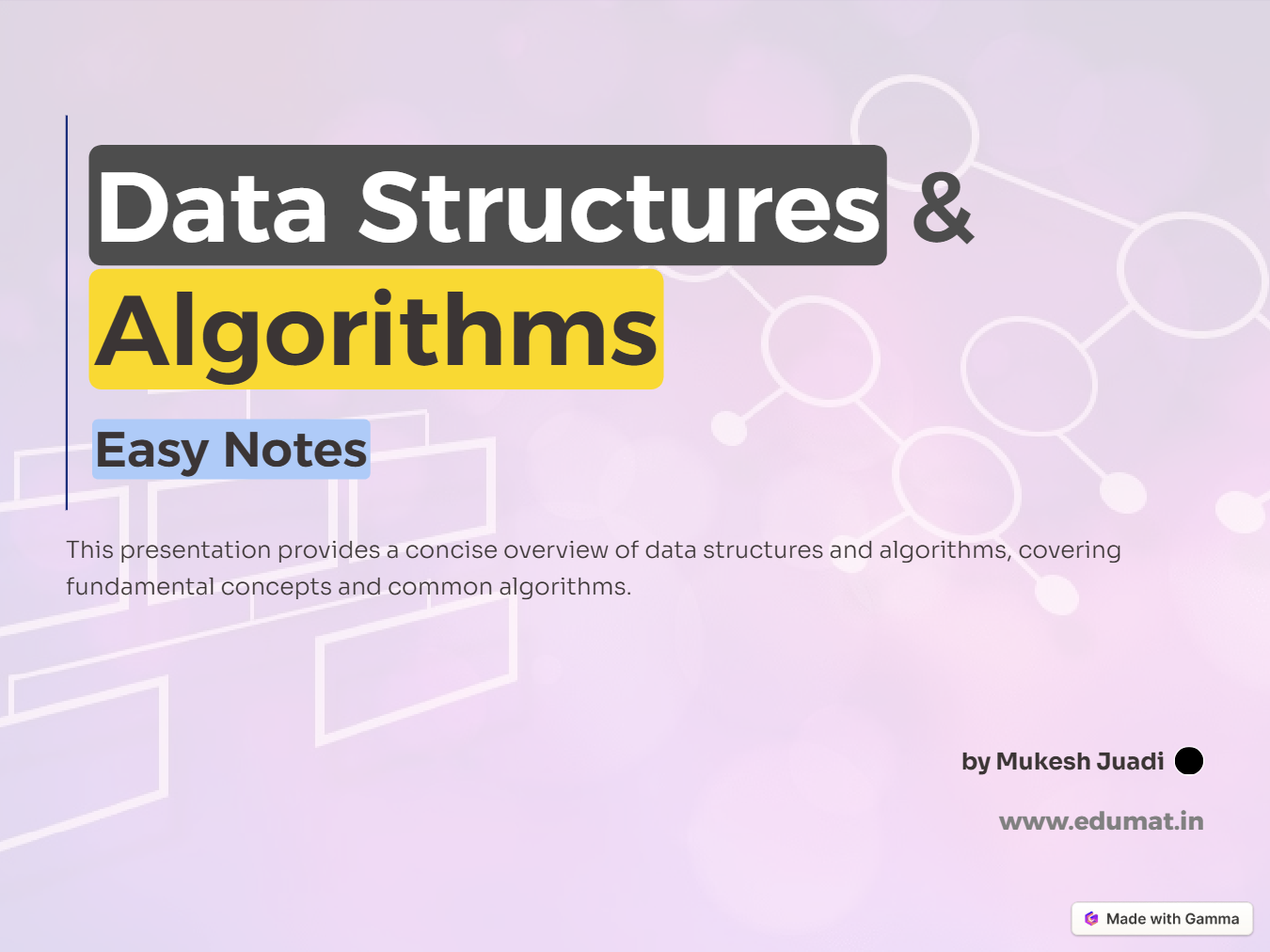Data Structures and Algorithms Easy Notes for Beginners
Programming • May 15, 2025

Mukesh Juadi

Hey there, coding enthusiasts! 👋 Ready to dive into the fascinating world of data structures and algorithms (DSA)? Don’t worry if you’re a beginner—I’m here to make it super easy and fun to understand. Think of this as your go-to guide for learning DSA from scratch. Let’s break it down step by step and get you ready to solve problems like a pro! 🚀
✨ What is a Data Structure? Let’s Break It Down
A data structure is like a toolbox 🧰 for organizing and storing data in a smart way. It helps you manage data so you can access, modify, or retrieve it quickly and efficiently. Imagine you’re organizing your closet—data structures are the shelves, drawers, and hangers that keep everything neat and easy to find!
Examples of Data Structures
Here are some common data structures you’ll encounter in programming:
- Array: Stores items in a straight line, like a row of books on a shelf 📚.
- Linked List: A chain of items where each one points to the next, like a treasure hunt map 🗺️.
- Stack: Follows LIFO (Last In, First Out)—think of stacking plates; you take the top one first 🍽️.
- Queue: Follows FIFO (First In, First Out)—like waiting in line at a store 🛒.
- Hash Table: Stores key-value pairs for quick lookups, like a dictionary 📖.
- Tree: A hierarchical structure, like a family tree 🌳.
- Graph: Shows relationships with nodes and edges, like a social network 🕸️.
Each data structure has its own superpower, making it perfect for specific tasks. We’ll explore how to choose the right one later! 😊
🧠 What is an Algorithm? Your Step-by-Step Guide
An algorithm is like a recipe 🍳 for solving a problem. It’s a set of instructions that, when followed, gets you to the solution you want. For example, if you’re baking a cake, the algorithm would be the steps: mix the ingredients, pour into a pan, bake at 350°F, and voilà—cake! In programming, algorithms tell the computer how to process data to get results.
📊 Understanding the Basics: Time and Space Complexity
Before we dive into algorithms, let’s talk about two key ideas that help us measure how good an algorithm is: time complexity and space complexity.
Time Complexity: How Fast is Your Algorithm?
Time complexity tells us how fast an algorithm runs as the size of the data grows. We use Big-O notation to describe the worst-case scenario. Here’s a quick rundown:
- O(1): Constant time—the fastest! It doesn’t care how big the data is (e.g., looking up a value in a hash table).
- O(n): Linear time—grows with the data size (e.g., searching through a list one by one).
- O(n2): Quadratic time—much slower, as it grows exponentially (e.g., nested loops in a sorting algorithm).
The goal? Always aim for the lowest time complexity to make your code run faster! 🚀
Space Complexity: How Much Memory Do You Need?
Space complexity measures how much memory your algorithm uses. It’s all about the storage needed for variables and data as the algorithm runs. For example, if you’re storing a huge array, that takes up more space than a single variable. Less memory usage = better efficiency! 💾
🔍 Common Algorithms You Should Know
Now that we’ve got the basics down, let’s explore some popular algorithms that you’ll use in programming. These are like your trusty tools for solving problems! 🔧
Searching Algorithms: Finding What You Need
- Linear Search: Check each item one by one, like searching for a book on a messy shelf. It takes O(n) time.
- Binary Search: Divide and conquer! Works on sorted data, cutting the search in half each time. Super fast at O(log n).
Sorting Algorithms: Putting Things in Order
- Bubble Sort: Compare adjacent items and swap them if they’re out of order. It’s simple but slow at O(n2).
- Merge Sort: Divide the list, sort smaller chunks, and merge them back together. Efficient at O(n log n).
- Quick Sort: Pick a pivot, partition the list, and sort. Also runs at O(n log n) on average.
Greedy Algorithms: Always Choose the Best Option
Greedy algorithms make the best choice at each step, hoping it leads to the overall best solution. For example, Dijkstra’s Algorithm finds the shortest path in a graph—like choosing the quickest route on a road trip! 🛤️
Divide and Conquer: Break It Down
This strategy breaks a big problem into smaller ones, solves them, and combines the results. It’s the idea behind Merge Sort and Quick Sort—divide, conquer, and win! 🏆
Dynamic Programming: Solve Once, Use Again
Dynamic programming (DP) breaks problems into smaller, overlapping sub-problems and stores the results to avoid repeat work. It’s perfect for things like calculating the Fibonacci Sequence or solving the Knapsack Problem (packing the most valuable items in a bag 🎒).
Backtracking: Try Everything and Back Up
Backtracking explores all possible solutions and backtracks if something doesn’t work. It’s like solving a maze 🧩—try a path, and if it’s a dead end, go back and try another. Examples include the N-Queens problem or navigating a maze.
📌 Key Takeaways to Remember
Let’s wrap up the big ideas in a nutshell:
- Data Structures: How you organize and store data—like shelves for your coding projects.
- Algorithms: Step-by-step instructions to process that data—like a recipe for success.
- Optimizing Performance: Pick the right data structure and algorithm to make your code fast and efficient.
🎯 Let’s Wrap It Up: Your DSA Journey Starts Here!
Mastering data structures and algorithms is like building a superpower for programming! 💻 From simple arrays and linked lists to advanced techniques like dynamic programming and backtracking, each concept has its own role to play. Start small, practice often, and watch your skills grow step by step. You’ve got this! 😊
🌐 Keep Learning with EduMat
Want to dive deeper into coding topics? Visit www.EduMat.in for more fun lessons and resources. Let’s keep the learning adventure going! 🌟
Dive Deeper with Our Slides
Check out our detailed Slides: Data Structures and Algorithms Easy Notes